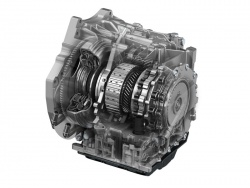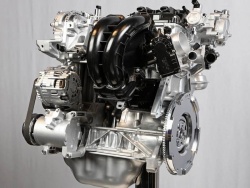 Mazda Skyactiv automatic transmission. Click image to enlarge |
|
Related links
Manufacturer’s web site |
By Greg Wilson
Photo Gallery:
Mazda Skyactiv technology
“Skyactiv” is Mazda’s fanciful term for the company’s next generation powertrain and chassis technologies designed to improve vehicle performance, safety, fuel economy and emissions. The company’s stated goal is to improve corporate fuel efficiency by 30 per cent by 2015, compared to 2008 levels. Skyactiv upgrades to its vehicles will begin this year in Japan with the Mazda2, and in Canada later this year with the 2012 Mazda3 and the new 2012 CX-5. Though Skyactiv will include future hybrid and electric vehicle technology, for the immediate future, the changes are to conventional internal combustion engines, transmissions, unit body platforms, suspensions and steering systems.
 Mazda Skyactiv diesel engine. Click image to enlarge |
“Mazda is renewing its entire powertrain and platform line-up at the same time as revolutionizing every manufacturing process from R&D through to mass production,” said Takashi Yamanouchi, Mazda’s Chairman of the Board, President and CEO. As if to reassure us that we won’t have to make any sacrifices, he added, “There have been no compromises in addressing conflicting goals.”
In Part 1 of our look at Skyactiv, we examined Mazda’s advances in engine technology, especially the planned introduction of Mazda’s improved diesel engines into North America next year. This week, we’ll take a look at Mazda’s advances in transmission, body, chassis, suspension and steering technologies.
Mazda’s new six-speed automatic transmission will be lighter and more compact than the company’s current automatic and will contribute a four to seven per cent improvement in fuel economy, according to transmission engineer, Toshihisha Marusue.
There will be two types of automatic transmissions: one able to handle up to 200 lb.-ft. of torque and another capable of handling up to 340 lb.-ft. They will both include a smaller torque converter for starting only and a multi-plate clutch for a more direct, connected feeling. As well, a new “Mechatronics” module in the transmission will combine the hydraulic control module and the ECU. Shift times of just 150 miliseconds will be faster than a dual-clutch transmission, according to Marusue.
  Mazda Skyactiv chassis (top) and rear suspension. Click image to enlarge |
A newly designed six-speed manual transmission optimized for front-engined front-wheel-drive cars will also be smaller and 30 per cent lighter than current transmissions and offer a more precise shift feel that requires less effort. Shift strokes are reduced from 50 mm to 45 mm, comparable to the MX-5 sports car. Marusue claims this manual transmission will have a direct, sporty feel but will also offer the lightest shift effort in its class. Like the automatic transmission, there will be two types: one for engines with up to 200 lb.-ft torque, and a second type for engines with up to 340 lb.-ft.
Mazda’s next generation vehicle bodies will be lighter, more rigid and offer better crash safety performance, according to body engineer, Norihiro Tomita. Key to the improved strength is a continuous ring frame around the cabin which improves bending rigidity by up to 30 per cent. Crash safety will be enhanced by the use of new front door supports, cross-shaped body pillars which absorb more crash energy, and more spot welds and bonding glue where appropriate. A typical unit body will be eight per cent lighter, in part due to the increased use of high tensile steel. And being lighter, the new body will help improve fuel economy.
Suspensions are also being reworked. In front strut/rear multilink suspensions, new suspension geometry includes front caster angles increased from four to seven degrees for increased agility and stability, rearranged rear multi-links and rear trailing arm, and a higher pivot point for the rear traction bars. These help to improve ride quality, cornering feel, high-speed stability and controlled braking. The new suspension design and thinner materials also means a 14 per cent reduction in suspension weight, another contributor to better fuel economy.
Lastly, Mazda has developed an improved electro hydraulic steering system with a shorter steering gear ratio for better steering feel and more driving pleasure.
Individually, none of these advancements is an earth-shattering achievement, but when you put them all together they amount to significant improvements in fuel economy, handling, safety and performance – without the need to develop alternate powertrains or alternate fuels. That’s the real genius of Skyactiv











